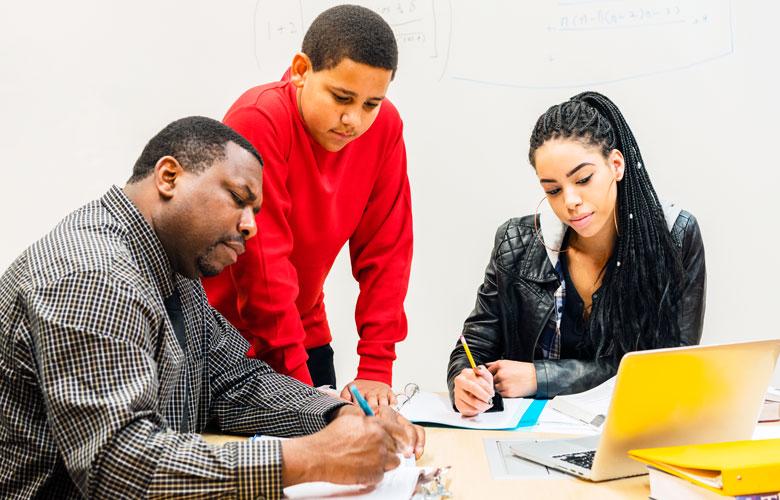
Mentorship can be a key component for success for youth in both life and school,1 including for youth who are pursuing computer science.2 In the rapidly evolving field of technology, having a mentor provides students with valuable guidance, industry insights, and practical advice that go beyond traditional classroom learning.
Mentors not only provide personalized support, they also help students navigate challenges, make informed career choices, and develop the motivation they need to succeed in a STEM career. Mentor-student relationships foster a sense of community and create a feeling of belonging for the students who need it the most.
However, one of the biggest challenges of any mentoring program is recruiting enough mentors—especially ones who reflect the lived experiences of the mentees they serve—and then retaining those mentors year to year. Using feedback from its mentors and other data sources, the Rhode Island Department of Education (RIDE) found a strategy to overcome this challenge in their computer science work-based learning initiative.
In 2019, RIDE and EDC received a grant to pilot a computer science course for high school students that featured mentorship. Students worked with industry mentors to design and develop computer science industry projects. Because of the challenges and difficulties of finding mentors, RIDE initially chose to take on the task of recruiting mentors and matching them to high schools piloting the course.
To validate whether our matching strategy would work, we used a continuous improvement (CI) process of data collection, analysis, and revision to analyze the program during its first two years and improve the strategy as needed. We collected program-related data from student feedback on their connections with their mentors, mentor interviews, mentor feedback at mentor communities of practice meetings, teacher feedback at quarterly CI meetings, and mentor recruitment and retention numbers. From these data, we were able to identify issues as well as successes to revise the mentoring program.
One issue we identified early on from student, teacher, and mentor feedback was that students’ lacked connection and engagement with their mentors. During mentoring sessions, students asked very few questions and talked sparingly. Additionally, since the program was launched in 2020, schools and many workplaces were remote due to the pandemic. Students, teachers, and mentors all found engaging online very difficult, and this lack of engagement likely contributed to only 11 out of 36 mentors returning for the second year.
Creating an environment where mentor-mentee relationships can grow is essential. We were determined to make sure students felt more supported and, therefore, motivated to continue to pursue an education and career in computer science.
From teacher feedback sessions, we learned about two creative solutions to help students better engage with mentors. One teacher asked mentors to create a few slides with details about themselves to share with students. This personal connection helped students feel more comfortable with their mentors and opened up additional conversations and ways of engaging together on the industry project.
Another teacher built on this idea as she assigned students to mentors. She first had all mentors introduce themselves to the students, and then she asked students to prioritize which mentors they wanted to work with. Giving students a choice of who to work with supported their engagement with the mentors.
As a result of these experiences, the training guides for both teachers and mentors were revised to include an activity during which mentors introduced themselves to the students and then spent time getting to know students on a personal level. When possible, students were given some measure of choice in selecting their mentors.
Mentor retention was another issue that surfaced. After the first year, more than two thirds of the mentors decided not to continue with the program. However, during mentor interviews, we heard from one mentor who was a former student in the school in which he was mentoring. He talked about how he could connect with the students because he had gone to the school. It was clear he had a passion for his community and wanted to give back. He was also one of the few mentors of color, reflecting the race and lived experiences of the majority Hispanic/Latino student body. Because of this mentor’s feedback, RIDE tried a new mentor recruitment strategy of working with schools to recruit mentors from community members and alumni. The collection and review of the next year of data revealed that this strategy worked.
Although we faced challenges in finding and retaining mentors, we were able to use the continuous improvement process to refine the mentorship program and improve recruitment, representation, and engagement. As a result, RIDE was successful in filling the mentoring spots needed for the program, finding mentors that students could connect with, and retaining more mentors for the following year.
Resources
To learn more about the continuous improvement process, visit these links:
- Strengthening Early Childhood Interventions with Continuous Quality Improvement | EDC
- Continuous Improvement Can Work in Your School | EDC
- A Primer for Continuous Improvement in Schools and Districts | EDC
| Anne Wang is a research scientist at EDC who leads continuous improvement projects focused on building the capacity of school and district staff to create sustainable systems change. |
1S. Res. 118th Congress, 2nd Session. Recognizing January as National Mentor Month (2024) (enacted). https://www.whitehouse.senate.gov/imo/media/
doc/national_mentoring_month_resolution_2024.pdf
2Williams, A. (2023, November). Cultivating Detroit’s future technology leaders today. https://www.edc.org/blog/cultivating-detroits-future-technology-leaders-today


Add new comment